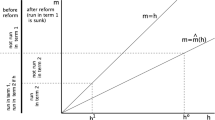Abstract
The literature on incumbency advantage has focused on margin as an indicator for electoral security. But while electoral margin is a goodex ante measure, it is a poorex post measure of security. Further, existing work has not integrated the choice of retirement with changes in the level of security. To improve the specification and definition of “marginality”, a multinomial LOGIT model is proposed where the dependent variable is categorical. Account is therefore taken of all the ways a Representative's term in office can end, including reelection, defeat, retirement, or pursuit of other office. The sample includes all U.S. Representatives elected for the first time between 1948 and 1978. The results indicate that (1) margin in the previous election is a significantex ante proxy for the probability of electoral defeat, and (2) while the electoral safety of all incumbents in the House has been increased, the increases are greater for members elected for the first time in the period since 1965.
Similar content being viewed by others
References
Ansolabehere, S., Brady, D. and Fiorina, M. (1992). The vanishing marginals and electoral responsiveness.British Journal of Political Science 22: 21–38.
Alford, J.R. and Hibbing, J.R. (1981). Increased incumbency advantage in the House.Journal of Politics 43: 1042–1061.
Born, R. (1979). Generational replacement and the growth of incumbent reelection margins in the U.S. House.The American Political Science Review 73: 811–817.
Cain, B.E., Ferejohn, J. and Fiorina, M. (1987).The personal vote: Constituency service and electoral independence. Cambridge, MA: Harvard University Press.
Collie, M.P. (1981). Incumbency, electoral safety, and turnover in the House of Representatives, 1952–76.American Political Science Review 75: 119–131.
Collier, K. and Munger, M.C. (1993). A comparison of incumbent security in the House and Senate.Public Choice, forthcoming.
Erikson, R.S. (1971). The advantage of incumbency in congressional elections.Polity 3: 395–405.
Erikson, R.S. (1972). Malapportionment, gerrymandering, and party fortunes in congressional elections.American Political Science Review 66: 1239–1241.
Ferejohn, J. (1974).Pork barrel politics: Rivers and harbors legislation, 1947–1968. Stanford, CA: Stanford University Press.
Ferejohn, J. (1977). On the decline of competition in congressional elections.American Political Science Review 71: 166–176.
Fiorina, M. (1989).Congress: Keystone to the Washington establishment, New Haven, CT: Yale University Press.
Garand, J.C. and Gross, D.A. (1984). Change in the vote margins for congressional candidates: A specification of the historical trends.American Political Science Review 78: 17–30.
Hibbing, J.R. (1982). Voluntary retirement from the U.S. House of Representatives: Who quits?American Journal of Political Science 26: 467–484.
Inter-university Consortium for Political and Social Research. (various years).Roster of United States congressional officeholders (computer files).
Inter-university Consortium for Political and Social Research. (various years).Candidate names and constituency totals, 1788–1988 (computer files).
Jacobson, G.C. (1987). The marginals never vanished: Incumbency and competition in elections to the U.S. House of Representatives, 1952–1982.American Journal of Political Science 31: 126–141.
Kiewiet, R. and Zeng, L. (1992). An analysis of congressional career decisions, 1947–1986. Division of Humanities and Social Sciences, California Institute of Technology. Manuscript.
King, G. (1989). Representation through legislative redistricting: A stochastic model.American Journal of Political Science 33: 787–824.
Krehbiel, K. and Wright, J. (1983). The incumbency effect in congressional elections: A test of two explanations.American Journal of Political Science 27: 140–157.
Mayhew, D.R. (1974a). Congressional elections: The case of the vanishing marginals.Polity 6: 295–317.
Mayhew, D.R. (1974b).Congress: The electoral connection. New Haven: Yale University Press.
Parker, G. (1980). The advantage of incumbency in House elections.American Politics Quarterly 74(October): 449–464.
Payne, J.L. (1980). The personal electoral advantage of House incumbents.American Politics Quarterly 74: 697–708.
Reed, W.R. (1990). How long do congressmen stay in office?Economics and Politics 2: 173–192.
Reed, W.R. and Schansberg, D.E. (1992). The behavior of congressional tenure over time: 1953–1991,Public Choice 73(2): 183–204.
Schansberg, D.E. (1992). Moving out of the House: An analysis of congressional quits. Department of Economics, Indiana University-Southeast. Manuscript.
Author information
Authors and Affiliations
Additional information
The authors acknowledge the helpful comments of James Friedman, Timothy McKeown, Terry Sullivan, and other participants at a workshop of the Faculty Working Group in Political Economy at the University of North Carolina at Chapel Hill. Any errors are the responsibility of the authors alone.
Rights and permissions
About this article
Cite this article
Coates, D., Munger, M.C. Win, lose, or withdraw: A categorical analysis of career patterns in the House of Representatives, 1948–1978. Public Choice 83, 95–111 (1995). https://doi.org/10.1007/BF01047686
Accepted:
Issue Date:
DOI: https://doi.org/10.1007/BF01047686




